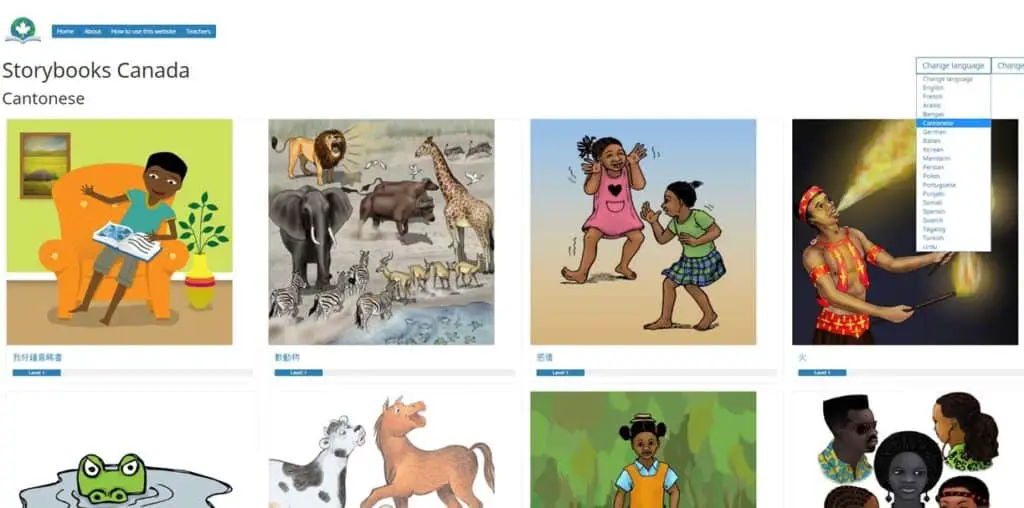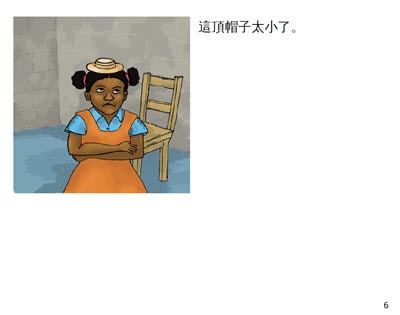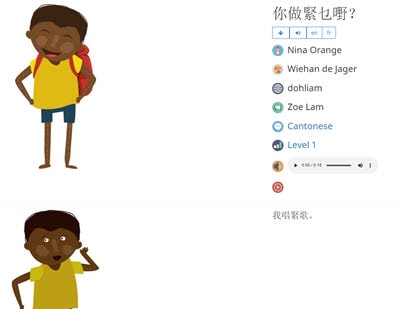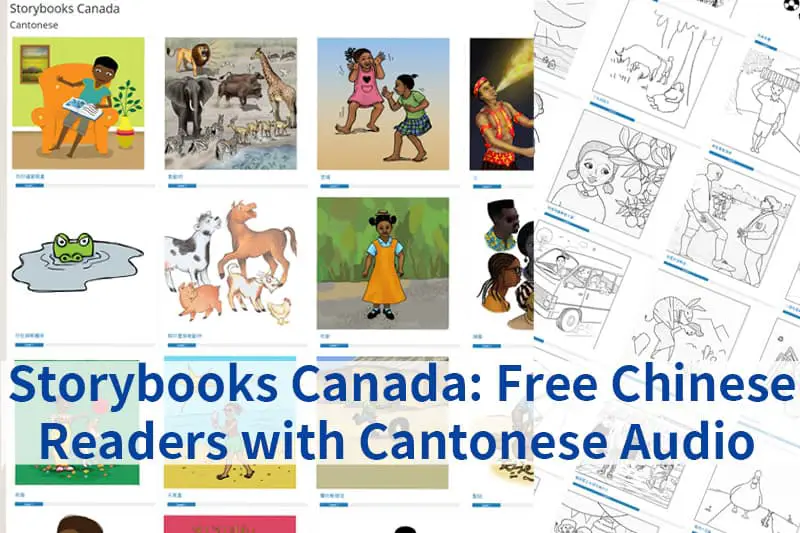Free Colloquial Cantonese storybooks with audio for kids are a rare find. Thanks to Storybooks Canada, a Canadian initiative aimed at promoting multilingualism, and helping children maintain their mother tongue in both oral and print form, there are now 40 stories available in many languages including Cantonese.
Storybook Details
Each of the 40 storybooks has multi-language audio options that reads out the text line by line according to the pictures. The Cantonese version is read by a native Cantonese speaker, and the text is in the written form of Colloquial Cantonese. This is a great resource, especially if you cannot read or write Chinese/ Cantonese.
The 40 stories are from the African Storybook, and help promote understanding of other cultures, while increasing exposure to Cantonese (and other languages). Books are divided into 5 reading levels.
| Level | Description | Words per story |
| Level 1 | One or two short, simple sentences per page | Up to 75 words |
| Level 2 | A few sentences per page | 76–250 words |
| Level 3 | A short paragraph per page | 251–500 words |
| Level 4 | One paragraph per page | 501–799 words |
| Level 5 | A long paragraph per page | 800 words or more |
How to use the website: There are instructions on the page how to use the site, including reading stories, listening and downloading stories.
What’s available for download
Overview
Written Cantonese – Colour Version

There many PDF options – regular PDFs, wordless, imageless, booklets format, monolingual, or bilingual (Cantonese with either French or English).
Also, Cantonese audio files are available for download. To download the various PDFs, you have to go to each individual story, and click on ‘download options’ in the top right corner.
You can also download them as a zip file from the download page , but only monolingual PDF is available.
Standard Chinese version in Simplified Chinese (Mandarin Audio)
This is quite straightforward to find, and it is just by selecting Mandarin at the drop down menu from the top right corner “Select Languages”. The text is in Simplified Chinese, and the audio in Mandarin.
Standard Chinese version in Traditional Chinese (Mandarin Audio)

To find Standard Chinese (Traditional Chinese) version, you have to click through to the Storybooks Hong Kong site (via the Global Storybooks Portal) .
There are less options for PDF downloads – only regular PDF monolingual is available (no bilingual options).
Printer friendly Outline Version

The original pictures are quite colour intensive. If you are after a printer-friendly black and white version, you can choose the outline version.
Outline version is only available for
- Written/ Colloquial Cantonese in Traditional Characters and Cantonese audio
- Standard Chinese in Simplified characters and Mandarin audio.
There is no Standard Chinese in Traditional Chinese version available. The PDFs are monolingual.
Other Languages
You can also read and download the books in many different languages. There are over 25 languages available on Storybooks Canada. If you cannot find the language you are looking for, click on the Global Storybook Portal button at the bottom of the page, and check out the Storybooks from the other countries. For example, I found Japanese under Storybooks Hong Kong and Storybooks Japan.
Summary of all download options and their corresponding website links:
Colloquial Cantonese (Traditional Chinese characters) e.g.我好鍾意睇書
- Colloquial Cantonese: Colour printout + Cantonese audio – various PDF options, individual download
- Colloquial Cantonese: Colour printout + Cantonese audio (in one big Zip file), – regular PDF monolingual
- Colloquial Cantonese: Outline version + Cantonese audio – regular PDF monolingual, individual download
Traditional Chinese e.g. 我喜歡看書
- Standard Chinese (Traditional Chinese characters): Colour printout + Mandarin Audio (Please note there are less options for the types of PDF download, and no Cantonese audio, but if you are teaching Cantonese, you might want to still download the PDFs)
Simplified Chinese e.g. 我喜欢看书
- Standard Chinese (Simplified Chinese): Colour printout in Simplified Chinese + Mandarin Audio – various PDF options, individual download
- Standard Chinese (Simplified Chinese): Colour printout in Simplified Chinese + Mandarin Audio (in one big zip file) – regular PDF monolingual
- Standard Chinese (Simplified Chinese): Outline version in Simplified Chinese + Mandarin Audio – regular PDF monolingual, individual download
The Mandarin audio is the same for simplified and Traditional Chinese characters.
Review of Level One
We are only at Level one books now, so that is all I can review at this stage. There are 15 books in all, and I like that they have a lot of repetition, making it easy to learn sentence structures and related vocabulary. This whole language approach is especially helpful for children like mine who started learning Cantonese as a pre-schooler, and not from birth.
 Take for example the text from one of the Level One books (What are you doing? 你做緊乜嘢?)
Take for example the text from one of the Level One books (What are you doing? 你做緊乜嘢?)
你做緊乜嘢? What are you doing?
我唱緊歌。I am singing.
佢揮緊手。She is waving.
我拍緊手。I am clapping.
佢伸緊手。She is stretching her hands
佢叫緊。He is calling.
我答緊。I am answering.
佢聽緊。She is listening
你做緊乜嘢?What are you doing?
This book will introduce the sentence structure Pronoun + verb + 緊 which will indicate someone is performing an action. The book will also introduce commonly used verbs.
If you are not very fluent at reading, you can also listen to the audio and then read to your child, or just play the audio for the child. The audio can be downloaded as an MP3 to your device.
How we are using the stories
Our family is screen-light, so I prefer to print the books out. Despite there being many download options, I had wanted one that would combine Standard Chinese and Colloquial Cantonese, so I had to create my own. I also go for the outline version to reduce the environmental impact. (I do feel some guilt over the paper use, but I plan to pass on the books after we are done, so that helps to assuage my guilt.). This is what I have done, book by book –

Having standard Chinese and Written Colloquial Cantonese differentiated:
In my customized booklet, there is the standard Chinese text in large font for my kiddo to read out. The Colloquial Cantonese text is in a smaller and different font, and in brackets, for myself to read to her. It is differentiated, so that she doesn’t mix it up. The Written Colloquial Cantonese ensures the text is read consistently in Cantonese to her each time and this consistency and repetition has very helpful in reinforcing the language.
‘Flashcards’:
I also write some new words and phrases on post-it notes or memo paper that double up as flashcards, which we revise throughout the week or play games with. (My plan was to print and make flashcards but never gotten round to it.).
Audio:
I downloaded the audio as MP3 and I play it occasionally in the car. If you have a reading pen, you could also use it.
Using the online version:
For those who use screens, the website is really good, as you can follow along with the audio. And you can have it in color without the guilt of environmental impact.
How about you?
Are you using any leveled readers to teach or learn Cantonese? Please leave us a comment if you have any recommendations. Or if you have any further suggestions how to further use these leveled readers to teach or learn Cantonese, please let us know!
You might also enjoy reading:
- Free Leveled Readers with Colloquial and Formal Cantonese Audio
- Our collection of Cantonese nursery Rhyme and Songs (Each come with a free lyrics printable. )
- Free Online Chinese Textbooks and Course Materials
- Colloquial Cantonese Kid’s Educational Resources and Printables
- Cantonese Storytime and Book Reading on YouTube
- How To Read To Your Child When Your Cantonese Is Not Fluent

